As one young O.D. in this article says, the way optometrists practice today is thanks to the legislative battles and clinical innovation of those optometrists who paved the way.
Here are a number of rising, young O.D.s who have picked up the challenge of legislation and innovation.
A Young Gun for Young’uns
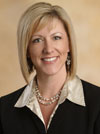 Optometrist Barbara Horn, age 37, has a thriving private practice in Washington, Mich., is the immediate past president of the Michigan Optometric Association and is the chair of the American Optometric Association Clinical & Practice Advancement Group Executive Committee. But one of her proudest achievements was spearheading the InfantSEE program in Michigan.
Optometrist Barbara Horn, age 37, has a thriving private practice in Washington, Mich., is the immediate past president of the Michigan Optometric Association and is the chair of the American Optometric Association Clinical & Practice Advancement Group Executive Committee. But one of her proudest achievements was spearheading the InfantSEE program in Michigan.
“I was an original State Leader for the InfantSEE Program at its inception. I helped to educate not only O.D.s about the need for them to be providers for the program, but also every legislator I come across to this day gets an educational spiel about our program and its importance,” Dr. Horn says.
It’s that kind of commitment that makes legislative efforts meaningful. To that end, Dr. Horn is currently the chair of Grassroots Optometry (GO!), a program in Michigan that links an MOA optometrist to every state legislator.
“A strong relationship with our legislators is key to keeping optometry in the game and on the winning side of the battles,” she says. One legislator even drove five hours to the MOA annual meeting to officially present the gavel to Dr. Horn when she was installed as president.
“Legislators are our friends,” she says. However, “they don't ‘get’ our profession. Why would they? They are not optometrists themselves.” Legislators, she says, don’t understand the importance of optometry “until it is very clearly laid out for them why it affects, and is important to, their constituents. That is our job. We are a legislated profession, so it is up to us to keep ourselves in the game.”
Social Media Maven
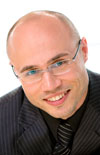 “I look at a computer as being able to do anything. It’s up to me to figure out how to get it to do it,” says optometrist Justin Bazan, age 31, who’s in private practice in Brooklyn, N.Y.
“I look at a computer as being able to do anything. It’s up to me to figure out how to get it to do it,” says optometrist Justin Bazan, age 31, who’s in private practice in Brooklyn, N.Y.
Dr. Bazan, in addition to his busy solo practice, is up to his eyeballs in computers and social media outlets, such as Facebook, Twitter, podcasts and several blogs. He is self-taught. “I grew up with computers. I was the kid who would relentlessly mess with the computer until I got it to do what I wanted it to do,” he says. Now, “I use a computer or my iPhone for everything. Seriously! My reality is truly digitally augmented, but it all blends perfectly.”
Dr. Bazan is now sharing his social media knowledge with other optometrists through lectures and—no surprise—through social media itself. Along with optometrist Nathan Bonilla-Warford (discussed later), Dr. Bazan is helping other O.D.s get up to speed with social media to help build and invigorate their patient base. (See their Facebook page, www.facebook.com/PeripheralVision, or their blog/podcast, http://peripheralvision.libsyn.com.)
“Optometry is the perfect profession to lead the social media revolution, [because] social media and optometry are both about making personal connections,” Dr. Bazan says. “The bonds we create with our patients and clients can be easily strengthened with the tools of social media. Generating loyal advocates of your practice will be aided with these tools. The new technology will aid in creating a patient-centric environment.”
But, having a Facebook page or website is itself not the end goal. Social media is just one means to an end. “Social media will not make you the best. But if you are the best, it will allow others to find out you are the best,” Dr. Bazan says. “Focus on being the best first, then embrace the tools that will let the world know you are.”
A Good Fit with Tough Fits
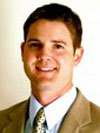 Optometrist Michael Mayers, 32, likes a challenge. He started up a solo practice cold, in Powell, Ohio, less than three years ago, and he quickly began fitting specialty contact lenses, which has really grown his contact lens patient base. He welcomes problem contact lens patients who have been turned away or simply offered glasses at other practices.
Optometrist Michael Mayers, 32, likes a challenge. He started up a solo practice cold, in Powell, Ohio, less than three years ago, and he quickly began fitting specialty contact lenses, which has really grown his contact lens patient base. He welcomes problem contact lens patients who have been turned away or simply offered glasses at other practices.
“I hear patients say ‘The doctor said I wasn’t a good candidate for contacts because of my astigmatism,’ or ‘The doctor said I wasn’t a good candidate because of my dry eye.’ But we have so many great products out there in contact lenses, contact lens solutions and dry eye therapies,” Dr. Mayers says. “So if the patient is motivated to wear contacts, we shouldn’t deny that. And that’s how I’ve built my practice.”
Dr. Mayers didn’t start out big. He intentionally started small, working by himself (no staff) in a 1,400-square foot, one lane office. Practice consultants had told him he’d need $300,000 to start up a reasonable practice. “I wouldn’t even know how to start to repay that note,” he says. Instead, he bought only the most necessary equipment. “I started fitting gas permeable multifocals with a basic keratometer,” he says.
Six months ago, he got a corneal topographer and added orthokeratology into his practice. The topographer should be paid off in a year, he estimates. Dr. Mayers is now looking to double his space by moving across the street to a 2,800-square foot office.
How did he do it? “New practitioners need to realize that they should be involved in specialty contact lens fits, such as gas perm multifocals, soft lens multifocals, and orthokeratology,” he says. Offering specialty contact lenses builds your total practice because it also enhances medical eye care, he says.
“Once you demonstrate your proficiency in contact lens technology and explain that contact lenses are medical devices, then the patient perceives you as an eye care specialist, which sets you up for the medical model,” Dr. Mayers says. “They know that you know what you’re doing with contact lenses, so they come back to you for all their other disease treatment—dry eye, allergies and all that. So contact lenses are a great segue for new practitioners to build that medical model.”
From Sea to See
 Experience as a Navy officer on a nuclear submarine was surprisingly good groundwork to become an optometrist, says Lieutenant Commander Manuel Zambrano, O.D., age 42. “Eight years of intensive and demanding technical training, discipline and service [on a sub] prepared me well for graduate studies in optometry,” he says.
Experience as a Navy officer on a nuclear submarine was surprisingly good groundwork to become an optometrist, says Lieutenant Commander Manuel Zambrano, O.D., age 42. “Eight years of intensive and demanding technical training, discipline and service [on a sub] prepared me well for graduate studies in optometry,” he says.
Dr. Zambrano was also the sole eye care provider for all the residents in Guantanamo Bay.
Now, Dr. Zambrano is the optometry coordinator of the newly established traumatic brain injury (TBI) clinic at the Naval Medical Center in San Diego (NMCSD), and he’s the Navy optometry community TBI Subject Matter Expert.
“Like glaucoma, the visual consequences of TBI can be insidious, life changing and potentially devastating to patients and their families,” Dr. Zambrano says. “Here at NMCSD, we’ve established a multi-disciplinary rehabilitative team—composed of different specialties like neuro-ophthalmology, neurology and vestibular, to name a few—in order to ensure early identification, monitoring and targeted, scientifically-based treatment, which is paramount for a successful outcome.”
Quite often, patients with TBI also have some form of visual impairment, such as optic nerve damage from concussive events. “Consequently, we’ve started to screen all service members who have experienced a concussive event as a result of explosive devices and projectiles,” Dr. Zambrano says.
What’s next? Dr. Zambrano is completing an online master’s degree in clinical vision research with an emphasis in TBI/ocular disease from Nova Southeastern University.
The Scientific Method
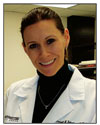 “When I started optometry school, it never crossed my mind to do anything other than private practice,” says Danielle Robertson, O.D., Ph.D., age 36.
“When I started optometry school, it never crossed my mind to do anything other than private practice,” says Danielle Robertson, O.D., Ph.D., age 36.
She certainly didn’t consider clinical research. But then, as a summer student at the University of Houston College of Optometry, she worked with Jan Bergmanson, O.D., Ph.D., who encouraged her to pursue a Ph.D.
Now, Dr. Robertson is a clinical scientist with her own lab, studying corneal cell biology. She’s also an assistant professor of ophthalmology at the University of Texas Southwestern Medical School, in Dallas. She was a two-time Ezell Fellow and a recipient of a Scientific Career Development Award from Research to Prevent Blindness. Among other accomplishments, she was recently awarded a research grant from the National Eye Institute to study, on a molecular level, how the corneal epithelium maintains itself.
“Before we can begin to fully understand the effects of lenses and solutions on the ocular surface, and how subsequent alterations in surface biology may potentially render the cornea susceptible to infection, we first need to have a good understanding of what is ‘normal.’ Surprisingly, little is really known in this area,” Dr. Robertson says.
She credits much of the success in her education to good mentorship. “I’ve been very lucky in this regard,” she says. “For the younger O.D.s just starting out, whichever avenue of optometry you pursue, identify a good mentor or mentors who can provide you with guidance and encouragement.”
On the home front, Dr. Robertson and her husband recently welcomed a baby boy. “Just like all the other moms out there, learning to juggle a career and a family is challenging,” she says, “but more fulfilling than anything I’ll ever see through a microscope.”
Legislative Lion
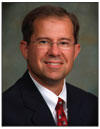 John Whitlow, O.D., 43, the legislative chair and former president of the Georgia Optometric Association, helped spearhead the 1997 bill that allowed Georgia optometrists to prescribe oral drugs.
John Whitlow, O.D., 43, the legislative chair and former president of the Georgia Optometric Association, helped spearhead the 1997 bill that allowed Georgia optometrists to prescribe oral drugs.
“Every bill at the Capitol is tough battle,” Dr. Whitlow says. But no battle can be fought alone. Each one requires grassroots efforts. “When we found out that the governor was thinking of vetoing our scope enhancement bill, Georgia optometrists flooded the Capitol with phone calls asking the governor to sign our bill,” he recalls. “It takes three aspects to work with legislators: educating them about our profession; personal relationships; and money.”
The legislative bug bit him early in his career as an optometry student, when his class went to a committee hearing on therapeutics. “I think for some of us, once you get a taste of it, it almost becomes addictive.”
Dr. Whitlow acknowledges that most young O.D.s (or O.D.s of any age) don’t share his interest in legislative affairs—until it arrives on their doorstep. “Maybe a course should be taught in all optometry schools on the history of optometry and the battles we have faced.”
All A-Twitter
 Nathan Bonilla-Warford, O.D., 36, is probably Tweeting right now. He’s at the forefront of using social media networking (Twitter, Facebook, Foursquare, and blogging) to build not just his Tampa practice—which he’s done quite successfully—but to become part of the local (and national) community.
Nathan Bonilla-Warford, O.D., 36, is probably Tweeting right now. He’s at the forefront of using social media networking (Twitter, Facebook, Foursquare, and blogging) to build not just his Tampa practice—which he’s done quite successfully—but to become part of the local (and national) community.
“Dr. Nate,” who started out as an optician, advocates that social media shouldn’t take the place of face-to-face interaction. Rather, it encourages human interaction. “Optometrists generally develop rich relationships with patients,” he says. “With the available tools of social media, it’s easy to extend this relationship online.”
For example, his practice hosted a baby day “Tweetup,” a face-to-face (not virtual) gathering of social media users. At this one, parents brought their babies for free InfantSee exams. Other local baby-oriented businesses also participated. Dr. Nate also originated Foursquare Day, which garnered national and international attention.
He constantly updates his website, Facebook profile and Twitter account with meaningful and fun content, and he always has a contest running. “Social media marketing is nothing more than a Chamber of Commerce mixer that never ends,” he says. “Everyone is so busy, it’s hard to network in person. Now, with social media, most or all of the small talk and icebreakers take place online so that our time together in real life is more efficient.”
Exam Educator
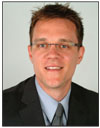 Optometrist Kyle Cheatham’s idea to launch an educational services company came to him in 2004, when he worked with two students who he says endured emotional and psychological impacts from failing the national boards. Now, KMK Educational Services, which provides educational courses to help pass the boards, has helped 3,700 students, and its services have expanded to serve 13 optometry schools.
Optometrist Kyle Cheatham’s idea to launch an educational services company came to him in 2004, when he worked with two students who he says endured emotional and psychological impacts from failing the national boards. Now, KMK Educational Services, which provides educational courses to help pass the boards, has helped 3,700 students, and its services have expanded to serve 13 optometry schools.
“Our first course was offered in 2005, and we helped raise the pass rate from 65% to 91% at that school,” Dr. Cheatham, 31, says. “Several of the schools we worked with last year had 95% or more of their students pass the exam.”
KMK aims to offer education that’s practical and easy to understand, Dr. Cheatham adds. “Our company is extremely passionate about the success of our students and the impact this can have on the profession. And we stress to our students that KMK is not about creating shortcuts for their success,” Dr. Cheatham says. “We want colleagues in the profession who are hard working and intelligent and who represent the best in the healthcare professions.”
In addition to KMK, Dr. Cheatham also works at Heartland Eye Consultants, a secondary care center in Omaha, where he specializes in ocular disease and low-vision rehabilitation.
Meanwhile, plans to expand KMK are already underway. Dr. Cheatham recently co-founded KMK Board Certification Services and Optometric Business Educators, which will launch in 2012. “Unlike a webinar where specific meeting times are required, (our) technology will allow the flexibility for a doctor to prepare at his or her own pace on their own schedule,” Dr. Cheatham says. “The other main concern for practitioners is having to pass a test. To increase the confidence of the doctor, our online program will have quizzes that mock the format of the [American Board of Optometry] exam.”
New Hope for Scope
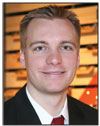 When KMK Educational Services approached optometrist Christopher Wolfe to help expand into national board certification preparation services, it seemed like a natural fit. Only 28, Dr. Wolfe has already accomplished much in his career, including working behind the scenes as a member of the Joint Board Certification Project Team. Additionally, he was president of the American Optometric Student Association as well as a member of the Nebraska Optometric Association Legislative Task Force.
When KMK Educational Services approached optometrist Christopher Wolfe to help expand into national board certification preparation services, it seemed like a natural fit. Only 28, Dr. Wolfe has already accomplished much in his career, including working behind the scenes as a member of the Joint Board Certification Project Team. Additionally, he was president of the American Optometric Student Association as well as a member of the Nebraska Optometric Association Legislative Task Force.
In this last role, Dr. Wolfe has worked tirelessly to expand the scope of practice in Nebraska, his home state, where he practices with his father in Omaha. “As students, optometrists learn about the battles their predecessors endured while trying to enhance the care they can provide to their patients,” Dr. Wolfe says. “I know the way I practice today is owed to the foundation those practitioners laid for me. I hope to continue to build on their success so the next generations can continue to provide care to the pinnacle of their knowledge, education and training.”
Having testified before the Nebraska Legislature, Dr. Wolfe says that on every level, optometry has the facts on its side during these scope battles. “I think every practitioner, young and old, should observe testimony at one of these hearings, if for no other reason than to understand why it is so important for us to be unified as a profession.”
In the future, Dr. Wolfe hopes to contribute to the enhancement of optometric practice in Nebraska and surrounding states, in addition to developing a process to reduce student debt and allow young O.D.s to practice in modalities of choice, not ones of necessity.
Mr. and Mrs. Young O.D. of the Year
For California-based husband and wife optometry team Derron and Leanne Lee, success runs in the family. These 34-year-old high school sweethearts own and operate two busy optometric practices, in Stockton and Manteca.
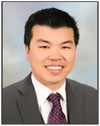
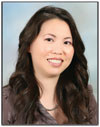
And, they are back-to-back winners of the California Optometric Association’s Young Optometrist of the Year Award. Dr. Derron Lee received the award in 2008, and Dr. Leanne Lee followed suit in 2009.
Dr. Leanne Lee oversees the pediatric care at the practices and is closely involved with the InfantSee program. “I am most proud of our Vision Therapy Clinic and the change that it has made for children and their ability to learn and better themselves,” she says. “My goal is to continue to develop the vision therapy service and educate parents, teachers and the general public about the importance of vision and its fundamental role in learning.”
Dr. Derron Lee focuses on ocular disease and laser surgery comanagement. “If you have diabetes, hypertension, dry eyes, or any eye related issues, I will take care of you. I am also a SynergEyes Hybrid contact lens-certified optometrist for those difficult contact lens prescriptions,” he says.
The Lees also enjoy giving back to the community. They both volunteer at local schools and the community center.
“I always love what I do, and I want the entire world to know it,” he says. “If you take care of your patients, they will reciprocate and take care of you. They will be confident and comfortable in referring their friends and family to you. The best compliment is receiving a referral from a current patient.”
